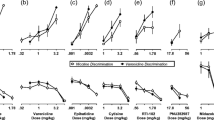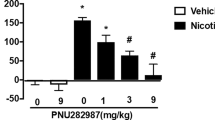Abstract
Rationale
Receptor mechanisms underlying the in vivo effects of nicotinic acetylcholine receptor (nAChR) drugs need to be determined to better understand possible differences in therapeutic potential.
Objective
This study compared the effects of agonists that are reported either to differ in intrinsic activity (i.e., efficacy) at α4β2 nAChR in vitro or to have in vivo effects consistent with differences in efficacy. The drugs included nicotine, varenicline, cytisine, epibatidine, and three novel epibatidine derivatives: 2′-fluoro-3′-(4-nitrophenyl)deschloroepibatidine (RTI-7527-102), 2′-fluorodeschloroepibatidine (RTI-7527-36), and 3′-(3″-dimethylaminophenyl)-epibatidine (RTI-7527-76).
Methods
Mice discriminated nicotine base (1 mg/kg base) from saline; other mice were used to measure rectal temperature.
Results
In the nicotine discrimination assay, the maximum percentage of nicotine-appropriate responding varied: 92 % for nicotine, 84 % for epibatidine, 77 % for RTI-7527-36, and 71 % for varenicline and significantly less for RTI-7527-76 (58 %), RTI-7527-102 (46 %), and cytisine (33 %). Each drug markedly decreased rectal temperature by as much as 12 ºC. The rank-order potency in the discrimination and hypothermia assays was epibatidine > RTI-7527-36 > nicotine > RTI-7527-102 > varenicline = cytisine = RTI-7527-76. The nAChR antagonist mecamylamine (3.2 mg/kg) antagonized the discriminative stimulus effects of epibatidine and RTI-7527-102, as well as the hypothermic effects of every drug except cytisine. The β2-subunit selective nAChR antagonist dihydro-β-erythroidine (DHβE; up to 10 mg/kg) antagonized hypothermic effects but less effectively so than mecamylamine.
Conclusions
The marked hypothermic effects of all drugs except cytisine are due in part to agonism at nAChR containing β2-subunits. Differential substitution for the nicotine discriminative stimulus is consistent with differences in α4β2 nAChR efficacy; however, collectively the current results suggest that multiple nAChR receptor subtypes mediate the effects of the agonists.







Similar content being viewed by others
Abbreviations
- DHβE:
-
Dihydro-β-erythroidine
- nAChR:
-
Nicotinic acetylcholine receptor
- RTI-7527-36:
-
2′-Fluorodeschloroepibatidine
- RTI-7527-76:
-
3′-(3″-Dimethylaminophenyl)-epibatidine
- RTI-7527-102:
-
2′-Fluoro-3′-(4-nitrophenyl)deschloroepibatidine
- ANOVA:
-
Analysis of variance
References
Abdrakhmanova GR, Damaj MI, Carroll FI, Martin BR (2006) 2-Fluoro-3-(4-nitro-phenyl)deschloroepibatidine is a novel potent competitive antagonist of human neuronal alpha4beta2 nAChRs. Mol Pharmacol 69:1945–1952
Ankier SI, Brittain RT, Jack D (1971) Investigation of central cholinergic mechanisms in the conscious mouse. Br J Pharmacol 42:127–136
Bergman J, France CP, Holtzman SG, Katz JL, Koek W, Stephens DN (2000) Agonist efficacy, drug dependence, and medications development: preclinical evaluation of opioid, dopaminergic, and GABAA-ergic ligands. Psychopharmacology 153(1):67–84
Carroll FI, Ware R, Brieaddy LE, Navarro HA, Damaj MI, Martin BR (2004) Synthesis, nicotinic acetylcholine receptor binding, and antinociceptive properties of 2’-fluoro-3’-(substituted phenyl)deschloroepibatidine analogues. Novel nicotinic antagonist. J Med Chem 47:4588–4594
Carroll FI, Brieaddy LE, Navarro HA, Damaj MI, Martin BR (2005) Synthesis and pharmacological characterization of exo-2-(2’-chloro-5-pyridinyl)-7-(endo and exo)-aminobicyclo[2.2.1]heptanes as novel epibatidine analogues. J Med Chem 48:7491–7495
Carroll FI, Ma W, Deng L, Navarro HA, Damaj MI, Martin BR (2010) Synthesis, nicotinic acetylcholine receptor binding, and antinociceptive properties of 3’-(substituted phenyl)epibatidine analogues. Nicotinic partial agonists. J Nat Prod 73:306–312
Coe JW, Brooks PR, Vetelino MG, Wirtz MC, Arnold EP, Huang J, Sands SB, Davis TI, Lebel LA, Fox CB et al (2005) Varenicline: an alpha4beta2 nicotinic receptor partial agonist for smoking cessation. J Med Chem 48:3474–3477
Cunningham CS, McMahon LR (2011) The effects of nicotine, varenicline, and cytisine on schedule-controlled responding in mice: differences in α4β2 nicotinic receptor activation. Eur J Pharmacol 654:47–52
Cunningham CS, McMahon LR (2013) Multiple nicotine training doses in mice as a basis for differentiating the effects of smoking cessation aids. Psychopharmacology (Berl) 228:321–333
Damaj MI, Creasy KR, Grove AD, Rosecrans JA, Martin BR (1994) Pharmacological effects of epibatidine optical enantiomers. Brain Res 664:34–40
Etter J-F, Lukas RJ, Benowitz NL, West R, Dresler CM (2008) Cytisine for smoking cessation: a research agenda. Drug Alcohol Depend 92:3–8
Le Foll B, Goldberg SR (2009) Effects of nicotine in experimental animals and humans: an update on addictive properties. Handb Exp Pharmacol 192:335–367
Gotti C, Riganti L, Vailati S, Clementi F (2006) Brain neuronal nicotinic receptors as new targets for drug discovery. Curr Pharm Des 12:407–428
Grady SR, Drenan RM, Breining SR, Yohannes D, Wageman CR, Fedorov NB, McKinney S, Whiteaker P, Bencherif M, Lester HA et al (2010) Structural differences determine the relative selectivity of nicotinic compounds for native alpha 4 beta 2*-, alpha 6 beta 2*-, alpha 3 beta 4*- and alpha 7-nicotine acetylcholine receptors. Neuropharmacology 58:1054–1066
Hall GH, Myers RD (1971) Hypothermia produced by nicotine perfused through the cerabral ventricles of the unanaesthetized monkey. Neuropharmacology 10:391–398
Holtzman SG (2000) Further characterization of the discriminative stimulus effects of spiradoline. Pharmacol Biochem Behav 66:517–522
Institute for Laboratory Animal Research (2011) Guide for the care and use of laboratory animals, 8th edn. Institute for Laboratory Animal Research, Division of Earth and Life Sciences, National Research Council, Washington, DC
Jutkiewicz EM, Brooks EA, Kynaston AD, Rice KC, Woods JH (2011) Patterns of nicotinic receptor antagonism: nicotine discrimination studies. J Pharmacol Exp Ther 339:194–202
Kenakin K (1997) Pharmacologic analysis of drug-receptor interaction. Lippincott Williams & Wilkins, New York
Koek W, Flores LR, Carter LP, Lamb RJ, Chen W, Wu H, Coop A, France CP (2004) Discriminative stimulus effects of gamma-hydroxybutyrate in pigeons: role of diazepam-sensitive and -insensitive GABA(A) and GABA(B) receptors. J Pharmacol Exp Ther 308(3):904–911
LeSage MG, Shelley D, Ross JT, Carroll FI, Corrigall WA (2009) Effects of the nicotinic receptor partial agonists varenicline and cytisine on the discriminative stimulus effects of nicotine in rats. Pharmacol Biochem Behav 91:461–467
McGranahan TM, Patzlaff NE, Grady SR, Heinemann SF, Booker TK (2011) α4β2 nicotinic acetylcholine receptors on dopaminergic neurons mediate nicotine reward and anxiety relief. J Neurosci 31:10891–10902
Oncken C, Gonzales D, Nides M, Rennard S, Watsky E, Billing CB, Anziano R, Reeves K (2006) Efficacy and safety of the novel selective nicotinic acetylcholine receptor partial agonist, varenicline, for smoking cessation. Arch Intern Med 166:1571–1577
Ondachi P, Castro A, Luetje CW, Damaj MI, Mascarella SW, Navarro HA, Carroll FI (2012) Synthesis and nicotinic acetylcholine receptor in vitro and in vivo pharmacological properties of 2’-fluoro-3’-(substituted phenyl)deschloroepibatidine analogues of 2’-fluoro-3’-(4-nitrophenyl)deschloroepibatidine. J Med Chem 55:6512–6522
Platt DM, Bano KM (2011) Opioid receptors and the discriminative stimulus effects of ethanol in squirrel monkeys: Mu and delta opioid receptor mechanisms. Eur J Pharmacol 650(1):233–239
Rollema H, Shrikhande A, Ward KM, Tingley FD 3rd, Coe JW, O’Neill BT, Tseng E, Wang EQ, Mather RJ, Hurst RS et al (2010) Pre-clinical properties of the alpha4beta2 nicotinic acetylcholine receptor partial agonists varenicline, cytisine and dianicline translate to clinical efficacy for nicotine dependence. Br J Pharmacol 160:334–345
Tallarida RJ (2000) Drug synergism and dose-effect data analysis. (Chapman Hall/CRC Press, Boca Raton, FL.)
Tobey KM, Walentiny DM, Wiley JL, Carroll FI, Damaj MI, Azar MR, Koob GF, George O, Harris LS, Vann RE (2012) Effects of the specific α4β2 nAChR antagonist, 2-fluoro-3-(4-nitrophenyl) deschloroepibatidine, on nicotine reward-related behaviors in rats and mice. Psychopharmacology 223(2):159–168
Funding
DA025267 to LRM
Conflict of interest
All authors declare no conflict of interest.
Author information
Authors and Affiliations
Corresponding author
Additional information
Jesse S. Rodriguez and Colin S. Cunningham indicate equal contribution.
Rights and permissions
About this article
Cite this article
Rodriguez, J.S., Cunningham, C.S., Moura, F.B. et al. Discriminative stimulus and hypothermic effects of some derivatives of the nAChR agonist epibatidine in mice. Psychopharmacology 231, 4455–4466 (2014). https://doi.org/10.1007/s00213-014-3589-z
Received:
Accepted:
Published:
Issue Date:
DOI: https://doi.org/10.1007/s00213-014-3589-z




